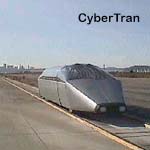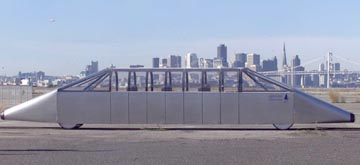Albany -- Officials award grants for CyberTran's Albany-to-Rensselaer
link
By CATHY WOODRUFF, Staff writer
First published: Sunday, June 16, 2002
 An innovative, automated light-rail system that would
shuttle passengers over the Hudson River between the Rensselaer train station and Empire
State Plaza is gaining momentum.
An innovative, automated light-rail system that would
shuttle passengers over the Hudson River between the Rensselaer train station and Empire
State Plaza is gaining momentum.
The $30 million project, which would use small, 6- to 20-seat train cars and
ultra-lightweight rails over the Dunn Memorial Bridge, has caught the eye of state and
federal officials, including state Senate Majority Leader Joseph Bruno, who pushed for a
$200,000 member item for the CyberTran project. It
came on top of a previous $150,000 member item steered by Bruno, R-Brunswick, for planning
and preparation work last year.
In a further signal that CyberTran may be rounding the curve toward a full-scale
demonstration project, the concept is said to be in contention for $15 million of state
funding, possibly from a new Empire Opportunity Fund created in this year's state budget
for economic development projects upstate and on Long Island.
CyberTran's developer, CyberTran International, is looking at a site in Saratoga County
for a final testing and development phase, and U.S. Rep. John E. Sweeney, R-Clifton Park,
is requesting a $5 million federal grant for the project in congressional budget talks.
"I think it offers us some real opportunities,'' said Sweeney, who serves on a
transportation subcommittee of the House Appropriations Committee.
Sweeney said the project is intriguing because it serves local transportation needs while
accomplishing a demonstration project for a technology with a potential worldwide market.
"I think this is the way of the future,'' Bruno said. "We've just got to make
sure it's feasible.''
 CyberTran, based on
a concept developed during the1980s at the Idaho National Engineering and Environmental
Laboratory and refined at a test track in Alameda, Calif., is being pushed locally by
Bethlehem resident Richard Arthur. He is president of a CyberTran International subsidiary
formed to develop and market the technology here.
CyberTran, based on
a concept developed during the1980s at the Idaho National Engineering and Environmental
Laboratory and refined at a test track in Alameda, Calif., is being pushed locally by
Bethlehem resident Richard Arthur. He is president of a CyberTran International subsidiary
formed to develop and market the technology here.
Arthur, 50, is looking to establish a test track in Malta on the property now being
pitched by the Saratoga County Economic Development Corp. for a high-tech industrial park.
The Alameda test track property on the San Francisco Bay is likely to be sold or leased
soon for other uses, Arthur said. The company wants a new test site to move the project
from a "raw engineering'' research phase into a more practical commercial-standard
testing environment.
"Plus, I want to build a local capability here,'' Arthur said. "This is going to
be a New York state operation. I want a complete capability in New York state to build
these things.''
If all goes as Arthur hopes, his company will build the Albany-Rensselaer CyberTran track
infrastructure in Saratoga County and then move it the few miles south for installation.
CyberTran cars resemble small versions of subway or light-rail trains. They are part of a
technological family known as "automated rapid transit,'' which operates without
drivers and travels on dedicated guideways. A defining feature of the CyberTran system is
its offline stations, which allow the cars to stop to pick up and discharge passengers
without disrupting the flow of other CyberTran vehicles using the line.
John Dearien, CyberTran International's chief executive officer, was one of the engineers
who conceived the CyberTran as a potential transportation system for workers commuting to
the U.S. Department of Energy's lab site near Idaho Falls, Idaho.
When a proposal that would have expanded the site's work force fell through, the CyberTran
development project was discontinued, but Dearien and his fellow engineers kept the right
to continue developing the technology.
Dearien, 60, said his company's current testing, being done in partnership with General
Electric and the Bay Area Rapid Transit system near San Francisco, focuses on control
system technology that BART also may use in its equipment.
It still is possible that CyberTran's next test track and demonstration site could land in
California if prospects there pan out first. But Dearien, who lives in Arkansas, said he
likes the idea of doing it in upstate New York. Among other things, he said, this region
would allow engineers to discern the effects of environmental variables such as ice, snow,
wet leaves and wide variations in temperature.
The demonstration project between Albany and Rensselaer is short of the full-scale
regional transportation network that Arthur and Dearien eventually envision for CyberTran,
but it would provide a critical step toward marketing their product for wider use here or
elsewhere. Public transportation contracts aren't handed out to unproven technologies,
Arthur noted, so a working demonstration project is the only way CyberTran can sell
itself. Arthur puts it this way: "The transit industry says, 'If you have not done
it, you may not do it.' ''
Recently, Arthur said, signs have been encouraging. A detailed engineering report by
Clough Harbour & Associates, made possible with Bruno's member item money, concluded
in March that the Albany-Rensselaer demonstration route is feasible. The report also
outlined three possible configurations for the track and stations.
Arthur said the Albany-Rensselaer project would offer a rare chance to start small while
filling a genuine transportation need.
John Poorman, director of the Capital District Transportation Committee, said one strong
selling point for transit systems such as CyberTran is their lower cost and potential for
wider service, compared with options like light rail, which has been considered for the
region's Northway corridor.
Experts put the capital construction costs for light rail systems, conservatively, at $40
million to $50 million per mile, while Arthur projects a per-mile cost of $5 million to
$15 million for CyberTran. Once on line, the operating costs of automated rapid transit
systems are a fraction of the operating costs for buses and other current mass transit
systems because individual drivers are not required, Arthur said.
"When you consider the heavy investment that's being made in many metropolitan areas
on light rail, the potential for something like CyberTran to be the public transportation
system for the 21st century is great,'' Poorman said. "The landscape is littered with
advanced transit technologies that are technically feasible but unaffordable.''
Aside from the Northway corridor and the short Rensselaer-to-Albany connection, Poorman
and other planners say, there are other routes in the region that could be ripe for a new,
faster transit option. Among the potential stops: college campuses in Albany, Schenectady
and Troy, Albany International Airport, the train station and shopping areas.
"In this whole area, you could actually envision a pretty useful set of
connections,'' Poorman said.
 An innovative, automated light-rail system that would
shuttle passengers over the Hudson River between the Rensselaer train station and Empire
State Plaza is gaining momentum.
An innovative, automated light-rail system that would
shuttle passengers over the Hudson River between the Rensselaer train station and Empire
State Plaza is gaining momentum. CyberTran, based on
a concept developed during the1980s at the Idaho National Engineering and Environmental
Laboratory and refined at a test track in Alameda, Calif., is being pushed locally by
Bethlehem resident Richard Arthur. He is president of a CyberTran International subsidiary
formed to develop and market the technology here.
CyberTran, based on
a concept developed during the1980s at the Idaho National Engineering and Environmental
Laboratory and refined at a test track in Alameda, Calif., is being pushed locally by
Bethlehem resident Richard Arthur. He is president of a CyberTran International subsidiary
formed to develop and market the technology here.